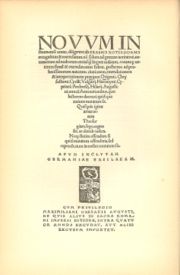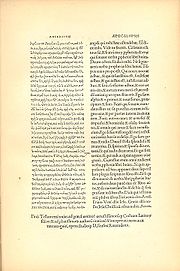- Novum Instrumentum omne
-
Novum Instrumentum omne was the first published New Testament in Greek (1516). It was prepared by Desiderius Erasmus (1469–1536) and printed by Johann Froben (1460–1527) of Basel. Although the first printed Greek New Testament was the Complutensian Polyglot (1514), it was the second to be published (1522). Erasmus used several Greek manuscripts housed in Basel, but some passages he translated from the Latin Vulgate.
Five editions of Novum Instrumentum omne were published. Of these four and five were not regarded as being so important as the third edition (1522), which was used by Tyndale for the first English New Testament (1526) and later by translators of the Geneva Bible and the King James Version. With the third edition, the Comma Johanneum was included. The Erasmian edition was the basis for the majority of modern translations of New Testament in the 16–19th centuries.
Contents
First edition
In 1512 Erasmus had been in negotiation with Badius Ascensius of Paris to publish the Vulgate of Jerome and a new edition of Adagia. It did not happen, and Erasmus did not continue contacts with Badius.[1] At that time Erasmus did not think about a Greek New Testament. It is uncertain when Erasmus decided to prepare his edition of the Greek New Testament, but on a visit to Basel in August 1514 he contacted Johann Froben. Many scholars believe that Froben had heard about the forthcoming Spanish Polyglot Bible, and tried to overtake the project of Alcala (e.g. S. P. Tregelles).[2] Some scholars doubt this motivation of Froben (e.g. Bruce Metzger), because there is no evidence to support it.[3] Most likely he included the Greek text to prove the superiority of his Latin version.
The next meeting took the place in April 1515 at the University of Cambridge. As a result, in July of 1515 Erasmus came to Basel and started his work. Johannes Oecolampadius served as his editorial assistant and Hebrew consultant.[4] Erasmus did not take any Greek manuscripts to Basel, hoping to find some there. He borrowed some manuscripts from the Dominican Library at the Basel. He used seven manuscripts, they were identified:[5]
Manuscript Content Date Minuscule 1eap the entire NT except Revelation 12th century Minuscule1rK Book of Revelation 12th century Minuscule 2e Gospels 12th century Minuscule 2ap Acts and Epistles 12th century Minuscule 4ap Pauline epistles 15th century Minuscule 7p Pauline epistles 12th century Minuscule 817 Gospels 15th century Manuscripts 1eap and 1rK Erasmus borrowed from Johannes Reuchlin. The rest of the manuscripts he borrowed from Dominicans.[n 1] It is significant that he did not use the Codex Basilensis, which was held at the Basel University Library, and was available for him. Erasmus had three manuscripts of the Gospels and Acts, four manuscripts of the Pauline epistles, but only one manuscript with the Book of Revelation. In every book of the New Testament he compared three or four manuscripts, except the last book, Book of Revelation. Unfortunately, this manuscript was not complete, it lacked the final leaf, which contained the last six verses of the book. Instead of delaying the publication, on account of the search for another manuscript, he decided to translate the missing verses from the Latin Vulgate into Greek. He used a corrupted manuscript of Vulgate with textual variant libro vitae (book of life) instead ligno vitae (tree of life) in Rev 22:14.[6] Even in other parts of the Book of Revelation and other books of the New Testament Erasmus occasionally introduced self-created Greek text material taken from the Vulgate. F. H. A. Scrivener remarked, that in Rev 17:4 he created new a Greek word: ακαθαρτητος (instead τα ακαθαρτα). There is no such word in Greek language as ακαθαρτητος.[7] In Rev 17:8 he used καιπερ εστιν (and yet is) instead of και παρεσται (and shall come). In Acts 9:6 the question that Paul asks at the time of his conversion on the Damascus road, Τρέμων τε καὶ θαμβὣν εἲπεν κύριε τί μέ θέλεις ποιῆσαι ("And he trembling and astonished said, Lord, what will you have me to do?") was incorporated from the Vulgate.[8][n 2]
The printing began on 2 October 1515, and in very short time was finished (1 March 1516). It was produced in great hurry, with typographical errors, and was unusually titled:
Novum Instrumentum omne, diligenter ab Erasmo Rot. Recognitum et Emendatum, non solum ad Graecam veritatem verum etiam ad multorum utiusq; linguae codicum eorumq; veterum simul et emendatorum fidem, postremo ad probatissimorum autorum citationem, emendationem et interpretationem, praecipue, Origenis, Chrysostomi, Cyrilli, Vulgarij, Hieronymi, Cypriani, Ambrosij, Hilaryj, Augustini, una cum annotatines, quae lectorem doceant, quid qua ratione mutatum sit.
This title, especially words: Novum Instrumentum ... Recognitum et Emendatum, means New Testament... Revised and Improved. This title must refer to the Latin text of Vulgate, not to any Greek text, because at that time there was not a printed edition of the Greek New Testament in circulation. In his dedication to Pope Leo X, Erasmus says:
I perceived that that teaching which is our salvation was to be had in a much purer and more lively form if sought at the fountain-head and drawn from the actual sources than from pools and runnels. And so I have revised the whole New Testament (as they call it) against the standard of the Greek original... I have added annotations of my own, in order in the first place to show the reader what changes I have made, and why; second, to disentangle and explain anything that may be complicated, ambiguous, or obscure.[9]
It was a bilingual edition, the Greek text was in a left column, Latin in a right column, and it is clear, the Greek text was not the first target of this edition, it was the Latin text of Vulgate.
Second edition
The reception of the first edition was mixed, but within three years a second was made. The second edition used the more familiar term Testamentum instead of Instrumentum. In the second edition (1519) Erasmus also used Minuscule 3 (entire NT except Revelation; 12th century). The text was changed in about 400 places, with most—though not all—of the typographical errors corrected. Some new error readings were added to the text.[10] In this edition the text of Jerome's Vulgate Erasmus replaced by his own more elegant translation.[8] The Latin translation had a good reception. After this edition, Erasmus was involved in many polemics and controversies. Particularly objectionable were the annotations from the universities of Cambridge and Oxford.[11]
López de Zúñiga, known as Stunica, one of the editors of Ximenes Complutensian Polyglot, reproached to Erasmus, that his text lacked part of the 1 John 5:7-8 (Comma Johanneum). Erasmus replied that he had not found it in any Greek manuscript. Stunica answered that Latin manuscripts are more reliable than Greek. In 1520 Edward Lee accused Erasmus of encouraging Arianism.[12] Erasmus replied that he had not found any Greek manuscript that contained these words, he answered that this was a case not of omission, but simply of non-addition. He showed that even some Latin manuscripts did not contain these words.[11][13]
Another attack was made in 1521 by Paulus Bombasius, the prefect of the Vatican Library, because in Greek text Erasmus departed from the common readings of the Vulgate. He informed Erasmus that in the Vatican Library is held an extremely ancient copy of the Scriptures (i.e. Codex Vaticanus). He sent two extracts from this manuscript containing 1 John 4:1-3 and 1 John 5:7-11 (it did not include Comma).
The second edition became the basis for Luther's German translation.[8]
Third edition
With the third edition of Erasmus's Greek text (1522) the Comma Johanneum was included. An often repeated story is that Erasmus included it, because he felt bound by a promise to include it if a manuscript was found that contained it. When a single 16th-century Greek manuscript subsequently had been found to contain it (Codex Montfortianus), Erasmus included it, though he expressed doubt as to the authenticity of the passage in his Annotations.[11][14] Henk Jan de Jonge, a specialist in Erasmian studies, stated that there are no explicit evidence that supports this frequently made assertion concering a specific promise made by Erasmus. The real reason to include the Comma by Erasmus, was his care for his good name and for the success of his Novum Testamentum.[15]
In this edition Erasmus, after using Codex Montfortianus, misprinted εμαις for εν αις in Apocalypse 2:13.[16]
The third edition differed in 118 places from the second.[17]
Oecolampadius and Gerbelius, Erasmus' subeditors, insisted that he introduce more readings from the minuscule 1 in the third edition. But according to Erasmus the text of this codex was altered from the Latin manuscripts, and had a secondary value.[18]
This edition was used by William Tyndale for the first English New Testament (1526), by Robert Estienne as a base for his editions of the Greek New Testament from 1546 and 1549, and by the translators of Geneva Bible and King James Version.
Fourth edition
Shortly after the publication of his third edition, Erasmus had seen the Complutensian Polyglot, and used its text for improvement of his own text. In the Book of Revelation he altered his fourth edition (1527) in about 90 passages on the basis of the Complutensian text.[19] Unfortunately Erasmus had forgotten what places of the Apocalypse he translated from Latin and he did not correct all of them.[20] Except in the Revelation, the fourth edition differed only in about 20 places from his third (according to Mill about 10 places).[20] The fourth edition was printed in three parallel columns, they contain the Greek, Erasmus' own Latin version, and the Vulgate.[19]
In November 1533, before the appearance of the fifth edition, Sepúlveda sent Erasmus a description of the ancient Vatican manuscript, informing him that it differed from the text which he had edited in favour of the Vulgate in 365 places.[21] We do not know anything about these 365 readings except for one. Erasmus in Adnotationes to Acts 27:16 wrote that according to the Codex from the Library Pontifici (i.e. Codex Vaticanus) name of the island is καυδα (Cauda), not κλαυδα (Clauda) as in his Novum Testamentum.[22][n 3] In another letter sent to Erasmus in 1534 Sepúlveda informed him, that Greek manuscripts were altered from the Vulgate.[23]
Final edition
The fifth edition of Erasmus, published in 1535, the year before his death, discarded the Vulgate. According to Mill the fifth edition differed only in four places from the fourth.[24]
Editions four and five were not so important as the third edition in the history of the Text of the New Testament.[25]
Popular demand for Greek New Testaments led to a flurry of further authorized and unauthorized editions in the early sixteenth century; almost all of which were based on Erasmus's work and incorporated his particular readings, although typically also making a number of minor changes of their own. Tregelles gives Acts 13:33 as an example of the places in which commonly received text did not follow Erasmian text (εν τω ψαλμω τω πρωτω → εν τω ψαλμω τω δευτερω).[26]
See also
Notes
- ^ Most of the manuscripts came from the collection that had been bequethed in 1443 to the Dominican monastery at Basle by John of Ragusa; see Bo Reicke, Erasmus und die neutestamentliche Textgeschichte, Theologische Zeitschrift, XXII (1966), pp. 254-265.
- ^ Hills concluded that Erasmus was divinely guided when he introduced Latin Vulgate readings into his Greek text. See Edward F. Hills, King James Version Defended!, pp. 199-200.
- ^ Andrew Birch was the first, who identified this note with 365 readings of Sepulveda.
References
- ^ Allen, P. C. (1963). The age of Erasmus. New York: Russell & Russell. pp. 144. http://ia331307.us.archive.org/2/items/ageoferasmus007430mbp/ageoferasmus007430mbp.pdf#page=148. Retrieved April 5, 2010.
- ^ "It appears that Froben, the printer of Basel, wished to anticipate the edition of the Greek Testament which was (as he heard) in preparation in Spain." See: S. P. Tregelles, The Printed Text of the Greek New Testament, London 1854, p. 19. The same point of view represents: Rummel, Erasmus Annotations on the New Testament, p. 23.
- ^ See: Bruce M. Metzger, Bart D. Ehrman, The Text of the New Testament: Its Transmission, Corruption and Restoration, Oxford University Press, 2005, p. 142.
- ^ J. Brashler, "From Erasmus to Calvin: Exploring the Roots of Reformed Hermeneutics", Interpretation 63(2) April 2009, p. 163
- ^ W. W. Combs, Erasmus and the textus receptus, DBSJ 1 (Spring 1996), 45.
- ^ Textual scholar Hoskier argued that Erasmus did not use Vulgate. Instead, he suggested that Erasmus used other Greek manuscripts such as 2049. See: H. C. Hoskier, Concernign the Text of the Apocalypse, vol. 2 (London: Bernard Quaritch, Ltd., 1929), p. 644.
- ^ F. H. A. Scrivener, A Plain Introduction to the Criticism of the New Testament, George Bell & Sons: London 1894, Vol. 2, p. 184.
- ^ a b c Bruce M. Metzger, Bart D. Ehrman, The Text of the New Testament: Its Transmission, Corruption and Restoration, Oxford University Press, 2005, p. 145.
- ^ "Epistle 384" in Collected Works of Erasmus. Vol. 3: Letters 222 to 223, 1516 (tr. R.A.B. Mynors and D.F.S. Thomson; annotated by James K. McConica; Toronto: University of Toronto Press, 1976).
- ^ S. P. Tregelles, An Account of the Printed Text of the Greek New Testament, London 1854, p. 25.
- ^ a b c Bruce M. Metzger, Bart D. Ehrman, The Text of the New Testament: Its Transmission, Corruption and Restoration, Oxford University Press, 2005, p. 146.
- ^ Edward Lee, Epistolae Aliquot Eruditorum Virorum (Basel, 1520)
- ^ S. P. Tregelles, An Account of the Printed Text of the Greek New Testament, London 1854, p. 22.
- ^ "Erasmus' annotations on the New Testament: Galatians to the Apocalypse", edited by Anne Reeve and M.A. Screech, Brill 1993, p. 770.
- ^ Henk Jan de Jonge, Erasmus and the Comma Johanneum, Ephemerides Theologicae Lovanienses 1980, p. 385
- ^ F. H. A. Scrivener, A Plain Introduction to the Criticism of the New Testament (George Bell & Sons: London, 1894), vol. 1, p. 200.
- ^ S. P. Tregelles, An Account of the Printed Text of the Greek New Testament, London 1854, p. 26.
- ^ S. P. Tregelles, An Introduction to the Critical study and Knowledge of the Holy Scriptures, London 1856, p. 208.
- ^ a b Bruce M. Metzger, Bart D. Ehrman, The Text of the New Testament: Its Transmission, Corruption and Restoration, Oxford University Press, 2005, p. 148.
- ^ a b S. P. Tregelles, An Account of the Printed Text of the Greek New Testament, London 1854, p. 27.
- ^ S. P. Tregelles, An Introduction to the Critical study and Knowledge of the Holy Scriptures, London 1856, p. 108.
- ^ Erasmus Desiderius, Erasmus’ Annotations on the New Testament: Acts – Romans – I and II Corinthians, ed. A. Reeve and M. A. Sceech, (Brill: Leiden 1990), p. 931.
- ^ Erasmi Opera, III, col. 1762.
- ^ S. P. Tregelles, An Account of the Printed Text of the Greek New Testament, London 1854, p. 28.
- ^ W. W. Combs, Erasmus and the textus receptus, DBSJ 1 (Spring 1996): 35-53.
- ^ S. P. Tregelles, An Account of the Printed Text of the Greek New Testament, London 1854, p. 29.
Further reading
- Tregelles, Samuel Prideaux (1854). An Account of the Printed Text of the Greek New Testament. London. http://www.archive.org/stream/a609739200treguoft#page/n3/mode/2up.
- Allen, P. C. (1963). The age of Erasmus. New York: Russell & Russell. http://ia331307.us.archive.org/2/items/ageoferasmus007430mbp/ageoferasmus007430mbp.pdf. Retrieved April 5, 2010.
- Metzger, Bruce M.; Bart D. Ehrman (2005). The Text of the New Testament: Its Transmission, Corruption and Restoration. Oxford: Oxford University Press.
- William W. Combs, Erasmus and the textus receptus, DBSJ 1 (Spring 1996): 35-53.
External links
- W. L. Adye, The History of the Printed Greek Text of the New Testament, Southampton 1865
- The Textus Receptus at the Encyclopedia of Textual Criticism
- M. Arhelger, Die Textgrundlage des Neues Testaments, 2006 (German)
- Johann Jakob Griesbach, Novum Testamentum Graece (London, 1809), Prolegomena, p. XVII ff
- Henk Jan de Jonge, Novum Testamentum a nobis versum
- Henk Jan de Jonge, Erasmus und die Glossa Ordinaria zum Neuen Testament
- Henk Jan de Jonge, Erasmus and the Comma Johanneum, Ephemerides Theologicae Lovanienses LXVI (1980), pp. 381–389
Categories:- Greek New Testament
- Early printed Bibles
Wikimedia Foundation. 2010.



